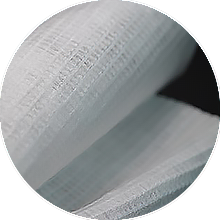Bi-Component Netting
Our proprietary netting technology lets you create truly distinctive products.
Bi-Component netting is made of two materials, one in each opposite direction, forming the web. Conwed can combine different, compatible resins in the same netting configuration but in opposite directions. For example, one bi-component netting design may include an elastomer material in the cross direction (CD) and polypropylene (PP) in the opposite direction (machine direction-MD). This netting could eventually be incorporated with other substrates under thermal lamination.
As another example of our bi-component netting capabilities, we could include polypropylene (PP) resin in one direction and ethylene vinyl acetate (EVA) in the opposite direction if the netting does not need to stretch. These are just two examples of the various combinations available in our bi-component portfolio.
The limits of our plastic netting technology are constantly tested, and we are accustomed to researching and testing chemical formulations that will deliver your desired performance.

Conwed™ Bi-Component Netting in Hygiene Applications
Conwed is the leading elastomeric netting in the world. Our bi-component technology allows us to develop elastomeric netting configurations with stretchability features in the cross direction (CD) and another resin in the machine direction (MD). These composites are often used in elastic waistbands for adult incontinence briefs and underwear.

Conwed™ Bi-Component Netting in Therapeutic Applications
Conwed™ Netting is often used in composite form to reinforce, laminate, stretch, and bond different substrates. In therapeutic wraps, our bi-component netting provided an elastomer in the cross direction (CD) and an ethylene vinyl acetate (EVA) in the machine direction (MD). This netting design helped create a stretchable composite with superior fit and drapeability for a therapeutic wrap.


